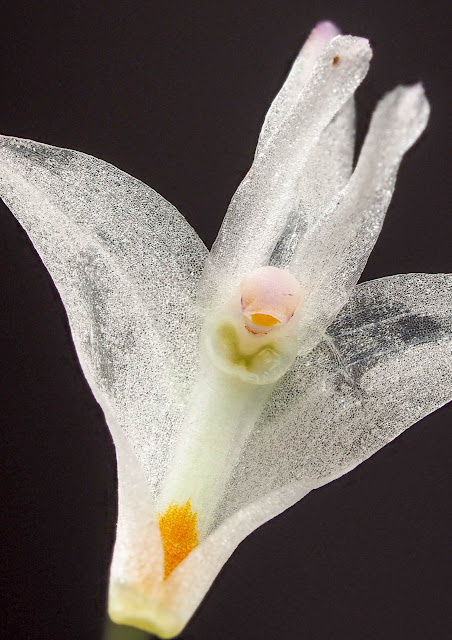I got this as Conchidium extinctorium from Tropical Exotique in spring 2018. This is the first bloom. It was transfered to Porpax in 2018 (see below). It was also in genus Eria at one point. It is a pretty interesting plant morphologically. The flower appears from the plant without leaves on a thin shoot, and wiggles around with a bit of wind. The pseudobulbs are compressed, and disc-like. The flowers don't look like typical Porpax, but the compressed pseudobulbs do look like them.
A phylogenetic trees of Eria and related genera were reconstructed from the nuclear ITS and four plastid regions (Ng et al. 2018). Conchidium (or Eria section Conchidium, but as shown in this paper, putting them into a section of Eria is not correct) forms a sister clade to Porpax. Actually they had only three species of Conchidium (C. pusilla, C. muscicola and C. lasiorhiza), and "Conchidium clade" consists of two of the three species. The problem is that Conchidium lasiorhiza was grouped within Porpax clade. I should note that the supports for the two clades appear to be low. Both Conchidium and Porpax spp. share vegetative similarities; discoid pseudobulbs, which can be covered in net-like pattern, short roots, and deciduous leaves. But typical Porpax spp. have fused tube-like (connate) sepals and Conchidium spp. have separate sepals. If C. lasiorhiza is truely nested within Porpax, this later distinction of the sepal morphology doesn't hold. So they proposed to transfer Conchidium into Porpax. African genus Stolzia is sister to these two groups, and their morphology looks similar to Porpax, so they also proposed to include this genus into Propax. I should note that after the reorganization of Eria relatives, Eria became a small genus with only 21 species.
I haven't figured out what would be good culture for this species. But my friends in OrchidsForum.com said that they grow intermediate to cool temperature with bright light, and cut back water drastically after leaf drop.
I don't know too much about this species, but I was curious how each component of the flower, so I'm posting photos of the dissected flower.
 |
| The lip was removed to show the arrangement of the petals and lateral sepals. |
 |
| Lip (adaxial surface, and flattened). It is a bit damaged from rough handling. The left half of the midlobe was removed to show the shape of the side lobe. |
 |
| Column, column foot, and ovary (side view). |
 |
| Column (from below, anther cap is twisted and loosely attached). Column foot (adaxial surface, the yellow side attaches to the lip). |
 |
| Pollinia, column (from above, the anther cap is still there), and column foot (abaxial surface, yellow side is the place where the lip attaches). |
We have been fly-fishing for arctic graylings every weekend. Today wasn't an exception. My son got sugar-loaded from Easter egg hunt in the morning. Last year, my wife was a bit sloppy and she re-used the plastic casings of easter eggs with rather unique patterns. He recognized them, and figured out that his mommy was actually the bunny. We made sure that he couldn't tell it to his friends, but he still enjoy the hunt. Then we headed to the usual place for fishing. He caught about 15 fish, and I got about 5. It wasn't too crowded, and we enjoyed (relatively) warm afternoon.
Literature cited:
- Ng, Y.P., Schuiteman, A., Pedersen, H.Æ., Petersen, G., Watthana, S., Seberg, O., Pridgeon, A.M., Cribb, P.J. and Chase, M.W., 2018. Phylogenetics and systematics of Eria and related genera (Orchidaceae: Podochileae). Botanical Journal of the Linnean Society, 186(2): 179-201.







Comments
Post a Comment